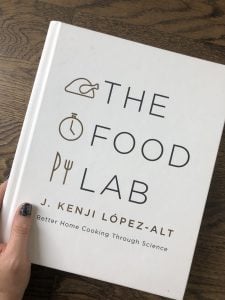What I Learned About Cooking Fish
The first thing I chose to research was cooking oils. I found this Bon Appétite article particularly helpful. I need to bookmark that shit because I’ve had to go back and find it a bunch of times since. Turns out sesame oil is a great choice for cooking salmon because it has a high smoke point and it lets the salmon flavor shine. At least we had picked a fitting cooking oil. Check.
So, Marcie originally crafted this recipe using store-prepared teriyaki sauce. I really want to use whole food ingredients as much as possible on this site. So, I put together a teriyaki sauce recipe. In the process, I learned quite a bit about teriyaki sauce, thanks to this awesome Japanese cooking site. Here we go with the fun facts 🙂 Did you know that teriyaki isn’t even a sauce? Author Nami explains that in Japanese, the word teriyaki refers to a way of preparing fish/meat. A common way to season something that has been cooked using the teriyaki method is to combine mirin (a Japanese, sweet rice wine), soy sauce, sake and sometimes sugar. This seasoning isn’t even sold at grocery stores in Japan. It is always homemade. Outside of Japan, this seasoning came to be known as teriyaki sauce, and the Americanized version developed to include things like garlic and ginger. Fascinating stuff.
So, I continued down the rabbit hole of cooking blogs in attempts to learn how to properly pan-roast salmon. I tried the recipe like two more times, and I STILL couldn’t get the salmon right! While I did learn quite a bit from poking around online, the most helpful was a book I bought a long time ago that was collecting dust in the corner of my kitchen. After diving into it, I now cannot recommend this book enough for people who want to get cooking basics and tips with science-based explanations: The Food Lab: Better Home Cooking Through Science. If you have it, check out pg. 371-376. J. Kenji López-Alt basically discusses all the ways people screw up salmon and how to prevent doing so in your own cooking. These tips apply also to other dense fish, like bass, halibut, grouper and snapper.

Want to Save this Recipe or Activity?
Enter your email and we will send it straight to your inbox! You’ll also get the latest posts from Platein28!
By submitting this form, you consent to receive emails from Platein28.
Here are my top takeaways:
- Always dry the fish before it goes into the pan. Moisture makes the fish stick to the pan.
- Heat the pan until it’s very hot and then add the oil. Once the oil is heated, add the fish and immediately turn the temperature down. This will provide for crispier skin and helps to avoid overcooking.
- It is preferable to cook salmon that has the skin on…and to start cooking it skin-side down. Attached under the skin is a layer of fat that a live salmon uses to insulate itself from extreme temperatures. When you cook a salmon skin-side down, the pan heat moves slowly through the fat barrier, allowing the salmon to cook more evenly. This also reduces the chance of overcooking.
- You want to cook the salmon almost completely skin-side down. You might have to use a fish spatula to flatten the fish down, as the sides might start to curl up. Once the fish is cooked at least 75% of the way through, flip the fish over and cook for 1-2 minutes more, max.
- The ideal temperature for the salmon is 125 degrees Fahrenheit (definitely no higher than 140). J. Kenji Lóopez-Alt recommends using this Thermapen instant-read thermometer.
These tips changed everything for me. My fourth attempt at our Teriyaki Salmon with Baby Bok Choy Recipe totally rocked. Haha. I hope this helps you too!
🍾 Cheers, Julie 🍾






